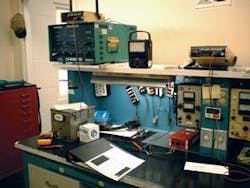Did you ever see a television commercial advertising a new universal wrench, which claims to be the replacement for all the open end, box, and adjustable wrenches currently in your toolbox? I can honestly say that enticing as the product appeared, there was no doubt in my mind that it would not provide the mechanical assistance needed to remove the retaining nut on a Falcon 50 windshield heat terminal strip. There were a few other tasks that came to mind where this universal wonder would not be my tool of choice.
On the other hand, I did see some areas where it could be of value. The same is true when it comes to the use of multimeters. There is not really any one device that will fulfill all the needs. Yeah, I have a toolbox with all the required hand tools. I also have a tool bag containing electrical testers. Five of which are multimeters, no, they are not all the same. Why five? Well if being an aircraft electrician with the last name of Sparks is not qualification enough, then it is because I have discovered over the years that one size does not fit all situations.
Tool Selection: What to Consider
Selection of the proper multimeter involves significant consideration. One concern is often cost. Just because you go out and spend hundreds of dollars does not always mean you get what you really need to do the job.
For me, the most important factor in selecting a multimeter is the specific purpose of the device. Will I be working in confined spaces where ambient light may be a factor? What about the ability of the unit to be supported in some condition other than flat on its back? How about switching functions when in a tight and blind location? Does it have an audible tone? If the use involves testing systems for either return to service or validation of operation, having an ongoing program to ensure calibration is essential. Available local support may be an issue if other than name brand equipment is used. Where it will be used and what will it be measuring are two significant concerns.
Just because another common name for a multimeter is a VOM (short for volt ohm meter) does not necessarily indicate that this is all the device can be used to measure.
How will it be used and what are the qualifications of those using it, may be other things to consider. The more functions that a device can accomplish oftentimes can make the appearance more intimidating to the inexperienced user. Frequently in general aviation it becomes necessary for a technician to determine if a light bulb is intact or verify continuity in a wire, fuse, or other electrical component. Testing a malfunctioning circuit for applied voltage is another common occurrence. If this is the primary reason for having an electrical tester, then a very basic unit may fit the bill.
Size in and of itself is often a factor and in part can be a consideration in the environment where the device is to be used as well as storage space. In a previous professional life I worked as a technical representative for an airframe manufacturer and had the opportunity to travel the world, often at a moment's notice, and had to assist operators by providing troubleshooting assistance. I have a small 1¼… by 3…” basic meter that would easily fit in a carry-on bag. This device was very inexpensive so if it were ever confiscated or lost, replacement would not be a big problem.
Know the Current Requirement
Analog or digital can be another factor in deciding on the best tool for a job. As a rule a digital meter will not impose a significant load on a circuit while it is operating. An analog meter on the other hand requires a certain amount of electrical current flow through the meter movement in order to produce a noticeable deflection of the pointer. In fact analog meter movements are rated in ohms per volt which will provide a reference to how much electrical current is needed to drive the needle.
One factor to always consider when dealing with electrical circuits is a term referred to "Flash Hazard Analysis." To determine the possibility and more important the potential hazard related to an electrical spark several factors are considered and include the operating voltage and the time required for circuit protection to react to a short. Most test equipment is rated for various applications where an electrical arc could occur and testing will verify the maximum safe voltage for use. When troubleshooting or testing electrical circuits, the test equipment is not the only thing requiring protection. Proper clothing, protective equipment and knowledge of the circuit being tested are all critical to ensure a safe outcome.
It takes a very low value of current, flowing through the human body, to cause death or serious physical harm. There have been many studies performed in this area with different values of current that cause each effect.
Most electrical test equipment is manufactured with some type of internal protection and it is always a good practice to create some type of standard procedures when using electrical measuring equipment. In some cases digital meters may be a bit more tolerant of installation errors than their analog counterparts. Some of the most common practices include:
- Select a range with a maximum value greater than you expect to be reading.
- Connect the meter, making sure the leads are positioned correctly. Digital meters can often be connected in reverse and display a reverse polarity, but an analog meter may be damaged.
- If the reading goes off the scale: immediately disconnect and select a higher range.
Multimeters are easily damaged by careless use and precautions are needed!
Analog as well as digital meters contain a battery and in the case of the analog it is used as a source of electrical current for the measurement of resistance. In the digital application the battery also is a supply for reading ohms but it is also used to power the display so virtually no power from the circuit under test is required to run the meter. This means that on their DC scale voltage they have a very high internal resistance (usually called input impedance) of 1 Meg ohms or more, usually 10 Meg ohms, and they are very unlikely to affect the circuit under test. In some cases analog meters are preferred when doing circuit resistance checks as a somewhat higher current flow is required to displace the indicator.
Digital meters often have a special diode test setting which enables a higher current flow to adequately bias or switch on the diode or semiconductor.
The fact there is an active battery or external power supply required for meter operation carries a certain stigma. I know for an absolute fact that the 9-volt battery installed in one of my testers is without any doubt capable of detonating certain aircraft engine fire extinguishers. (Don't ask how I know!)
On or Off?
Understanding the symbol key on the meter face is paramount to successful operation (See chart at left).
The function selection on the face of the tester should also be a consideration. In some cases an OFF position is included and No, OFF is not an abbreviation for On Full Force.
This is of course the safest position to place the selector anytime the tool is not actively being used. In some cases multiple switches have to be configured to first determine what the meter is measuring and second determine the anticipated range of the requested parameter.
Reading a meter will first of all require an understanding of the prefixes which are displayed in metric units. Some multimeters have a feature called auto range. This means that when selected to a circuit the display will determine how the information is presented. When troubleshooting a circuit it can sometimes be rather confusing when using this automatic feature while trying to interpret the readout. The important thing to note is the abbreviation identifier often accompanying the reading in the meter display. (See chart.)
Frequently testers with auto range features have a minimum/maximum hold capability.
This is a valuable asset when diagnosing faults with modern-day aircraft. All too frequently voltage surges can cause numerous avionics components to behave in unusual ways.
Additional Troubleshooting Capabilities
Adaptability and availability of accessories can turn a basic VOM into a diagnostic dynamo. Devices such as amp clamps will extend the amperage monitoring range of the device from perhaps 10 amps to several thousand without even interrupting the circuit.
Various kinds of temperature modules combined with thermocouple probes enable the technician to monitor what might be otherwise undetectable areas for overheat or cold soak problems.
Oscilloscopes have been considered by many to be the electrical measuring tool of choice for many applications. In recent years Scopemeters have become very popular troubleshooting devices. These can allow the technician to accomplish all the basic functions of a VOM plus observe digital data streams and even locate electrical noise that can often interfere with the operation of electronic systems. While a typical oscilloscope is rather bulky and often requires an external power supply, scopemeters are now not much larger than a common multimeter and contain their own internal battery. The use of such a device requires a bit more knowledge of electrical principles and the cost is frequently significantly higher for brand name equipment.
Proper Use and Testing Procedures
Procuring a meter is really only half the battle. Without proper test leads the functionality will be limited. Most VOMs come with a basic set of straight probes.
Various clamps, clips, and adaptors can transform a basic tester into a very useful tool. Proper care and maintenance of test leads is critical. An intermittent conductor or a corroded or burnt contact in a meter test lead can corrupt the troubleshooting process for even the most capable technician. It is also a good practice to ensure any internal meter batteries are replaced at regular intervals. Even the lead connection to the tester may require some concentration. In some devices multiple receptacles are located on the meter face and attention to specific function is important to ensure proper operation.
Well, I never did go out and buy one of those universal wrenches I saw on television and I have to this day still not removed my JetStar Starter Generator wrench or any other special mission tool from my toolbox, nor do I intend to!
About the Author

Jim Sparks
Jim Sparks has been maintaining aircraft for almost 40 years with the majority of the time involving Business Aviation activities. Jim’s endeavors have placed him on six of the seven continents contending with numerous situations from routine flight dispatch to critical AOGs. His career includes maintainer, avionics/electrician, educator, tech rep, and director of aircraft maintenance. In addition to other activities he is engaged with ASTM assisting in the global development of criteria defining the Next Tech for NEXTGEN. You can reach him at [email protected].
